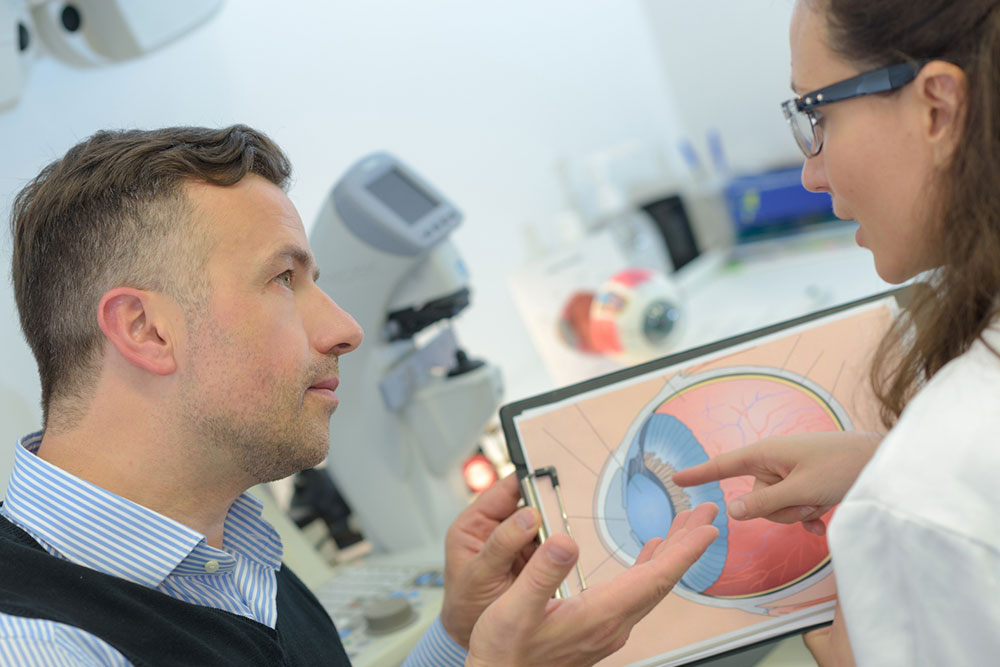
Macular degeneration – Types, symptoms, causes, and remedies
Macular degeneration (AMD) is a long-term eye disease that affects the macula, an area of the retina that controls center vision. It typically affects people over 65. One’s sharp center vision slowly worsens because of this condition, making it harder to do everyday things like reading and driving. In developed nations, macular degeneration is the main reason why older people lose sight. This article details the types of the condition, its symptoms, causes, and remedies.
Types of macular degeneration
Macular degeneration can mainly be classified into two types:
Dry macular degeneration
This form is more common, accounting for about 90% of cases. It occurs when small yellow deposits, called drusen, accumulate beneath the macula, leading to its deterioration over time.
Wet macular degeneration
Less joint but more severe; this type involves the growth of abnormal blood vessels beneath the macula. These vessels tend to leak blood and fluid, causing rapid damage to the macula and leading to vision loss.
Symptoms of macular degeneration
The symptoms of macular degeneration may develop gradually and vary from person to person. Here are the common symptoms associated with macular degeneration:
Blurred or distorted central vision
This symptom often manifests as a decrease in the sharpness and clarity of central vision. Objects may appear blurry or hazy, making it challenging to read, recognize faces, or perform tasks that require clear central vision.
Difficulty recognizing faces
Macular degeneration can lead to difficulty in recognizing faces, especially in well-lit conditions. Facial features may become less distinct or may appear distorted.
Increased sensitivity to glare
Individuals with macular degeneration may experience heightened sensitivity to bright lights or glare. Exposure to sunlight or bright indoor lighting might cause discomfort or difficulty seeing clearly.
Decreased intensity or brightness of colors
A common symptom is a reduced ability to perceive colors vividly. Colors may appear less vibrant or washed out, particularly in the central field of vision.
Straight lines appearing wavy or crooked
A distinctive symptom of macular degeneration is the appearance of straight lines as distorted or wavy. For instance, the lines may appear curved or broken rather than straight when looking at a grid pattern.
It is important to note that these symptoms often affect central vision while leaving peripheral vision intact. In the early stages, individuals may not notice significant changes in their vision, so routine eye exams are vital for early detection and management of macular degeneration.
As symptoms may vary and overlap with other eye conditions, anyone experiencing changes in their vision, especially if it involves central vision, should promptly seek evaluation by an eye care professional for proper diagnosis and management. Early detection and intervention can help decrease the development of the disease and preserve vision to the greatest extent possible.
Causes of macular degeneration
While the exact cause remains unclear, several risk factors are associated with the development of macular degeneration:
Age
The risk increases with age, particularly for individuals over 60.
Family history
Having a family history of macular degeneration increases the risk.
Hypertension
Having high blood pressure can make AMD worse and make it more likely to happen.
Remedies and lifestyle changes
Although there is no definitive cure for macular degeneration, certain lifestyle modifications and remedies may help slow its progression:
Healthy food plans
A food plan abundant in antioxidants, vitamins (especially A, C, and E), omega-3 fatty acids, and zinc may help keep your eyes healthy and lower your risk of getting worse.
Regular exercise
Habitual physical activity can aid in maintaining overall health and potentially reduce the risk of advanced macular degeneration.
Use of sunglasses
Sunglasses that stop UVA and UVB rays can help keep your eyes healthy by shielding them from UV rays.
Treatment options
How to treat macular degeneration depends on what kind of situation it is and how bad it is:
Dry macular degeneration
Currently, no treatment exists to reverse the effects of dry AMD. However, regular monitoring and lifestyle changes are recommended to slow its progression.
Wet macular degeneration
Treatments such as anti-VEGF (vascular endothelial growth factor) injections, photodynamic therapy, and laser surgery may be employed to manage wet AMD by reducing the progression of abnormal blood vessels.
Sometimes, low-vision rehabilitation services may help individuals maximize their remaining vision through aids like magnifiers, special lighting, and vision training.
In conclusion, macular degeneration is a prevalent eye condition that affects many individuals as they age. Early discovery through regular eye exams and living a healthy lifestyle by eating well and abstaining from certain substances can have a significant effect on how fast the disease spreads. There is no cure for macular degeneration, but treatments and changes to a person’s lifestyle can help them deal with it and improve their life.




